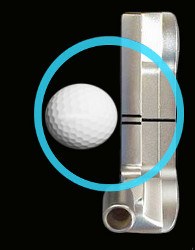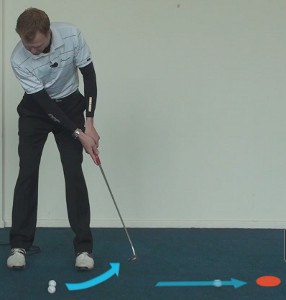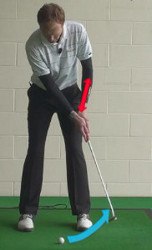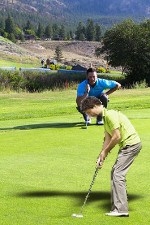
Confidence on the greens can be fickle, to say the least. Sometimes, all it takes is one missed putt – typically from close range -- to send one's self-belief plummeting.
Next thing you know, you're trying to wish the ball into the hole, rather than making it happen. The stroke becomes tentative. You try to steer the ball on line, and lift the head early in hopes of seeing it drop. These faulty moves cause deadly deceleration, unwanted hand action and destructive upper body motion, making the problem that much worse.
You must nip this pattern in the bud before it takes root. If you feel your confidence slipping after a miss, don't start analyzing every inch of your stroke. Instead, check your fundamentals – that's usually where the issue lies.

- Alignment: Take the time to position the ball's alignment aid precisely with your intended line, then place the putter so its alignment guide matches the ball's. Take a quick glance at the hole, but focus intently on stroking the ball on the chosen path.
- Ball position: This can vary from golfer to golf, but in general, placing the ball slightly forward of the center of your stance (toward the left foot, for right-handers) works best. If you've got it too far forward, you'll tend to pull putts. Too far back and you'll push the ball.
- Head movement: It's imperative to keep your head still throughout the stroke. On short putts, wait for the sound of the ball dropping into the cup before looking up. From farther out, count to 2 or 3 seconds before peeking.
Stroke length: On putts of less than 5 feet, think short and sweet. If the back-stroke is too long, you'll decelerate at impact and pull the ball. Practice making a minimal back-stroke, then exaggerate the follow-through so that it's much longer.
Use the same motion on your actual attempt.

Back to Basics When Putting Issues Pop-Up
The path to lower scores runs through your putter. There is just no way around it – if you want to play good golf, you have to putt well. While you might be able to hide from other parts of your game, you simply can't hide from an uncooperative putter. If your driver is giving you trouble, for example, you can opt to hit other clubs from the tee to get the ball in play. You can't do the same thing with your putter. The putter is needed on nearly every single hole you will ever play, so building a good relationship with this club is essential.
Of course, as you already know, you are bound to run into putting trouble from time to time. It happens to everyone – even the best golfers in the world go into slumps with the putter on occasion. When these putting issues do arise, the key is to be able to rediscover your form as quickly as possible. You don't want to have to spend weeks or months trying to get your stroke back, as you will have to suffer through a lot of ugly rounds during that time. Instead, you should do your best to get your stroke back in just one or two practice sessions.
In this article, we are going to provide advice which we hope will improve your putting performance in short order. Instead of trying to learn a new technique, all we will be doing here is working on returning you to your previous form. You have putted well in the past, so you know it can be done. Along the way, some part of your physical or mental approach strayed off track, and you are paying the price currently. With attention to detail and a little bit of hard work, we should be able to locate your prior putting success in the relatively near future.
You may have noticed, in the previous paragraph, we said that you have gotten off track from a 'physical or mental' perspective. It is important to keep in mind that both your physical technique and your mental approach are important. A good physical stroke is going to do you no good without the right mind set, and vice versa. Only when you have your mind and body working together properly will you be able to succeed on the greens with the consistency necessary to shoot low scores.
All of the content below is based on a right-handed golfer. If you happen to play left-handed, please take a moment to reverse the directions as necessary.

An Observational Approach
To get started, we are going to look at ways you can track down changes to your physical technique. Later, we will address the mental side of your putting performance, and how it can change over time. In this section, we are going to talk about the observational approach to correcting your putting. In other words, you are going to attempt to fix your stroke by looking for ways in which it might have changed.
Of course, you can't really see yourself while you are putting, so there are two main options here – ask someone else to watch you putt, or record yourself putting on video so you can take a look. Each option has its pros and cons, which will be highlighted below.
- Asking a friend for help. If you regularly play with at least one other person, you could ask him or her to watch your putting stroke over the course of an upcoming round. Do they see anything that looks out of place? Do they notice any differences from the stroke you usually use? This method may lead to positive results, but only if you have an observant and experienced friend. If this friend is relatively new to the game, or if they don't pay much attention during your rounds, they won't be able to offer anything in the way of constructive advice. You should only use this approach if you are confident that your friend is going to be able to help steer you in the right direction.
- Using video. Thanks to the recent improvements in technology, it is now easier than ever before to capture video in your day-to-day life. In fact, you probably have a device capable of taking video within arm's reach as you are reading this article. Or, you may be reading this article directly on a device that can take video. Either way, you shouldn't have to work too hard to set up a situation where you can record yourself making a few putting strokes. This will be helpful in that you can compare what you see on the video to what you are feeling during the stroke. For instance, you might not think that you right hand is being too aggressive through the ball, but you might see that it is causing problems when you watch the recording. On the downside, you aren't used to watching yourself putt – so you probably don't know what your stroke looks like normally. Unless you regularly tape your putting sessions, you will not have anything to compare this video to, and that can be a problem. Don't rule out this method, but don't expect it to work miracles, either.
As you can see, each of the observational methods have pros and cons. To achieve the best results, you might want to use a blend of both techniques. Ask a friend to watch you putt, and also record a video so you can watch for yourself. When you blend these two methods together, it is possible that you will come away with a better understanding of where your stroke is today and where it needs to go to get back on track.

A Results-Based Approach
You may not even need to look at your putting stroke – or have someone else look at it – to figure out what has gone wrong. With a results-based approach, you are going to judge your stroke based solely on what is happening to the ball after it is struck. Using the outcomes of your putts as a guide, you can zero in on your putting problems with surprising accuracy.
The following points are going to outline some of the common problems seen on the greens, and what they might mean with regard to your putting technique.
- Missing putts to the right. As a right-handed golfer, missing putts consistently on the right side of the hole means trouble for your stroke. When you push the ball out to the right, your stroke is not releasing properly and the blade is being held open at the moment of impact. From a technical perspective, you are not using your shoulders correctly during the motion. Your shoulders should have primary control over your putting stroke when things are working well. When something is wrong, however, your shoulders will slow down and your hands and arms will pick up the slack. To get back on track and rolling the ball in the right direction once again, try hitting some one-handed putts during practice. Taking one of your hands off the putter is going to require you to use your shoulders more actively to perform the stroke. After a few one-handed practice putts, put your other hand back on the club and take note of any improvements.
- Missing putts to the left. The most-likely cause of missing your putts to the left is an overactive right hand during the forward stroke. As mentioned in the previous point, you should be trusting your shoulders to do most of the work when you are hitting putts. If your right hand has to take over as you approach impact, the putter face may close down and the putt will likely miss to the left. When this happens, it is usually because your hands don't feel like you have made a long enough stroke to send the ball the appropriate distance for the putt at hand. Try making a slightly longer backstroke for most of your putts to counteract this error. With a longer stroke giving you plenty of power to reach the hole, you can let your right hand simply go along for the ride.
- Hitting your putts too hard. Again here, this could be a problem with your right hand. Not only will an overactive right hand tend to pull the ball to the left, but it will also usually hit your putts too hard. If you regularly hit your putts too hard while also missing to the left, try putting with a weaker grip to take your hands further out of the equation. Turn both of your hands to the left on the grip of the putter before starting your stroke. This positioning will make it harder for the right hand to get in the way as you putt – leaving your shoulders to do the job they are intended to do.
- Coming up short. One of the most common mistakes seen when putting is leaving the ball short. If a majority of your putts come up short of the hole, there is a good chance you are lifting your head up out of the putt before contact has been made. This is a classic amateur mistake, and it is one that nearly every golfer has made from time to time. When you lift your head up early, the level of the putter rises and you typically make contact too low on the face. Since you will have missed the sweet spot, you won't have as much energy transfer from the club to the ball, and the putt will wander up short of the cup. Focus on keeping your head down by watching the ball intently and only allowing yourself to look up after the ball has been sent on its way.
For most golfers, using a results-based analysis is going to be more effective than an observational approach. You can easily assess your current putting performance by where you are missing, and then use that information to diagnose problems with your technique. You will find that this method is extremely reliable, and it will help you correct errors in your stroke more times than not. It may take a bit of practice to actually see the benefit from the changes you make, but at least you can be confident that you are moving in the right direction.

Changes Between the Ears
The changes that take place with regard to your putting between your ears can be just as damaging as the changes that take place with your physical technique. If you start to think differently about how you approach the challenge of putting, your results could fall off dramatically – even if you are making the exact same physical stroke.
There are a number of ways in which the way you think about putting can go wrong. The list below contains some of the most common issues in this area.
- Loss of confidence. This is the big one, of course. When you start to lose confidence in your ability to make putts, you will inevitably see a drop in your performance. You will start to second-guess your stroke and your reads, and you will be more nervous while standing over the ball. A confident putter is a threat to make any putt he or she attempts – while on the other hand, a player with low confidence can miss even the shortest, easiest putts. It isn't always easy to recover your confidence when it starts to slip, but that is exactly what you need to do. One of the best ways to find confidence that had been lost is to head to the practice green at every opportunity. By making as many putts as possible in practice with nothing on the line, you can slowly rebuild your belief in your ability to make putts on the course. Specifically, try to hit a lot of short putts during practice so you can see the ball fall in the cup over and over again.
- Too much confidence. That's right – having too much confidence can lead to putting problems as well. This is certainly not as common as losing confidence, but it does happen from time to time. When you become overconfident, a couple of things are likely to happen. First, you may find yourself hitting putts too hard. After all, you expect to make every putt you look at, so why worry about the comeback putt, right? Not so fast. Even if you are feeling good on the greens, which is a good thing, you should never plan on making every putt. Some of them are going to miss, regardless of how well you are putting. Always respect your comeback putts and manage your speed wisely to avoid a costly three putt from an easy position. Another problem that stems from overconfidence is failing to pay enough attention to your reads. You might think that you can just walk up and roll the ball in the hole without paying too much attention to detail. That would be a mistake. You always need an accurate read if you are going to make plenty of putts. Even when your confidence is high, take a moment to get a great read before settling in and sending the ball on its way.
- Fear of one specific mistake. When you start to notice a pattern taking place in your putting game, that pattern can get in your head. For example, imagine a situation where you were continually missing your short putts to the right of the hole. At first, you wouldn't think anything of it. Everyone misses short putts from time to time, so it is no big deal if a couple putts slide past on the right edge. Over time, however, this would become more concerning. As you continue to miss to the right, you may start to worry about this mistake while making your stroke. Of course, making moves to compensate for that miss is the logical next step. You might use a little more right hand at impact to steer the ball back to the left – but this move could cause you to miss left instead of right. Pretty soon, your putting stroke will be in your head, and you won't know how to relax and just roll the ball toward the hole. To get out of this cycle, you are going to need to go back to the basics. Work on the simple fundamentals in your stroke, and see some success on the practice green. By proving to yourself that you can still make putts in practice, you will hopefully be able to carry over that success onto the course.
Mental game changes on the greens can happen fast. One day, you are feeling great about the way you are putting – and the next day you aren't even sure if you can make a tap-in. Pay attention to any changes you notice in your mindset and respond accordingly. You don't want to go too long with negative thinking on the greens, as it will get harder and harder to fix your way of thinking as this problem lingers. Commit yourself to thinking clearly while putting and you should succeed more often than you fail.

The Three Essential Keys
To wrap up this article, we wanted to highlight the three putting keys that all golfers should keep in mind. These are the very basics of the putting stroke, and they will help even the most experienced golfer make more putts. Take some time to focus your putting practice on these keys and you will be a better player for the effort.
- Lower body stability. All great putting strokes are built on a stable lower body. At address, you should have your knees flexed and your feet a comfortable distance apart. You should feel athletic and as though you could stand in this position for some time. Forcing yourself into an awkward or uncomfortable position is not going to be a productive way to putt. Once the stroke has started, you need to hold your lower body as still as possible. There should be no movement taking place from the waist down while the putter swings. One good way to make sure you are staying still is to focus on your knee caps. If you can hold your knee caps right where they are, you can be confident that your lower body is doing its job.
- Head perfectly still. So far, both of our keys have to do with holding your body in place. That should tell you everything you need to know about what makes a great putting stroke. Just like your lower body, you are going to hold your head perfectly still while the putter swings. It will be tempting to look up to see where the ball is going to go, but that is a classic mistake. There is no reason to look up, as you can't control anything that happens after the ball leaves the face of the putter. Keep your head down, let the putter swing through freely, and only look up well after the ball is gone.
- Shoulders do the work. It is not your hands or wrists that are in charge of moving the putter – it is your shoulders. If you can rock your shoulders back and through, you will be doing everything necessary to hit a great putt. Your hands should be quiet on the grip of the club, and your wrists should not bend in either direction. When done properly, this type of stroke feels incredibly simple, and it sends the ball perfectly down the target line over and over again.
It is frustrating to suddenly lose your ability to make putts. Fortunately, you should be able to regain that ability pretty quickly with a combination of critical thinking and hard work. Use the advice offered in this article to hopefully get your putting performance moving in the right direction in short order. Good luck!





